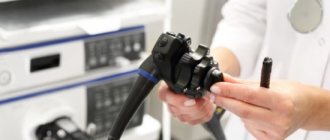Duration of colonoscopy
Diagnostic colonoscopy is a minimally invasive test, which means that upon completion the patient does not require hospitalization and is sent home. But if the procedure is carried out for therapeutic purposes (surgery), sometimes special preparation is necessary, with the introduction of infusion solutions, and subsequent observation, then the patient is hospitalized. For example, with intestinal bleeding, it may be necessary to restore the volume of circulating fluid, so saline solutions and blood components are administered.
How long a colonoscopy will last depends on the scope of the study and additional manipulations. For example, if it is necessary to perform a biopsy, remove a polyp, or stop bleeding, it will take more time than during a regular examination. Therefore, the duration of the study ranges from 10 to 50 minutes, rarely more. The duration of the procedure may also be affected by the use of anesthesia.
Expensive consultation
In other cases, the attractive cost of colonoscopy under anesthesia can be combined with an expensive consultation with gastroenterologists, without which the procedure is considered impossible according to the clinic’s rules. Therefore, patients should clarify all the conditions for undergoing a colonoscopy in advance, and do not hesitate to ask additional questions. We should also not forget that it is not worth saving on diagnostics, since health directly depends on the quality of the specialist’s work and the general standards of medical care.
And yet, what is better - a colonoscopy under anesthesia or without it, the doctor must decide.
Colonoscopy is the most accessible method in medicine for diagnosing pathology of the large intestine. A video camera placed at the end of the endoscopic tube helps to visually examine the surface of the intestine and identify polyps, ulcers, scars, and tumors. Doctors believe that the procedure should be performed on all adult patients over 50 years of age in order to detect the initial stage of cancer. Colonoscopy under anesthesia has indications or corresponds to the patient’s wishes.
People with a high threshold of pain sensitivity can withstand it without anesthesia. Others find it too unpleasant and painful. Colonoscopy is recommended annually for adults with the following conditions:
- unclear bleeding from the anus;
- Iron-deficiency anemia;
- tendency to diarrhea;
- weight loss;
- inflammatory bowel diseases;
- persistent abdominal pain.
The essence of diagnosis
Video colonoscopy is carried out using a special device that has a long flexible hose, at the end of which a mini video camera is installed. Through a flexible hose, various microinstruments can be introduced for manipulation and air to straighten the folds of the intestine for examination.
During the procedure, the doctor inserts a hose into the rectum and gradually advances it. The image from the camera is sent to the monitor, guided by it, the diagnostician carefully examines the mucous membrane, takes pieces of tissue from suspicious areas. Therefore, it is difficult to immediately determine how long an intestinal colonoscopy will last, because you need to examine the entire colon, and there may be several lesions.
Sensations experienced during colonoscopy
It is known from medical and non-medical sources that the mentioned endoscopic examination involves inserting a flexible (soft silicone) probe with specialized equipment at the end into a person. Insertion is supposed to be into the anus (anus), an intimate place, which means that a number of psychological experiences are associated: a fundamental reluctance to show a hidden area of the body, embarrassment, shame for possible natural discharge or odors, dilemmas of a psychosexual nature (homophobia). In addition to the emotional block, those preparing to undergo a colonoscopy face the task of overcoming the pain threshold. What causes the pain? “The culprits of pain” are divided into two categories – those that depend on the subject and those that occur independently.
Dependent causes include a person’s behavior during the study. In this circumstance, the psychological component plays a negative role. Excessive constraint, inability to fully relax, defensive body movements - the probe rests on the walls of the rectum or clings to the villi of the skin of the anus, creating pain. It is possible to avoid worries with the right approach.
High-quality preparation plays an important role in the successful completion of a colonoscopy. Insufficient cleaning of the loops of the colon and rectum leads to uneven accumulation of fecal residues in the lumens. A passing probe can get stuck in the contents and give inaccurate results in further diagnostics, and if the mass is too hard, it can slip off and cause microtrauma to the intestinal walls. To avoid such troubles, you must strictly follow your doctor’s recommendations when choosing a diet before the procedure.
Causes of pain independent of the individual include pain that occurs directly during the test. To accurately examine the condition of the walls of the large intestine, the doctor is forced to artificially dilate the organ - this is done by blowing air. The jets expand the intestinal lumen, forcibly stretching it - the reaction of the organ is quite painful, the patient involuntarily feels it. The main task of the helping nurse is to prevent sudden movements in the patient, otherwise there is a risk of sudden intestinal injury. Pain may occur during direct collection of cell samples (biopsy) during the procedure. Incoming pain syndromes must be taken into account by the diagnosing medical professional, otherwise they can result in a severe painful shock.
How long does it take to prepare for a colonoscopy?
To ensure that intestinal contents do not interfere with the examination, it is necessary to properly prepare the intestines. To do this, 2-3 days before the procedure, the patient is prescribed a slag-free diet, and the day before the procedure, intestinal cleansing. Cleansing is carried out using:
- cleansing, siphon enema;
- microenemas;
- laxatives.
The cleaning method is chosen by the doctor.
How long does it take to prepare for a colonoscopy procedure? If it is necessary to urgently perform a colonoscopy, one cleansing enema in the morning 1–2 hours before the procedure may be sufficient. But in such a situation, due to insufficient preparation, the information content will decrease and it will take longer. Therefore, preparation should be carried out within 2-3 days.
Contraindications
Colonoscopy may be contraindicated for patients. Namely, those who have a history of:
- heart and pulmonary failure;
- peptic ulcer;
- peritonitis.
It is also not recommended to carry out this study for people with blood clotting pathologies, or if there is an infectious process in the body in the acute stage.
Colonoscopy is contraindicated if in the large intestine:
- multiple lesions by tumor neoplasms;
- massive damage by adhesions.
Children under 12 years of age are not prescribed a colonoscopy without anesthesia.
Colonoscopy and rectosigmoidoscopy
In such cases, instead of a colonoscopy, a study is performed - sigmoidoscopy. But after the patient has undergone appropriate treatment and the above pathological conditions have passed, a colonoscopy can be performed.
Duration of the study itself under and without anesthesia
Colonoscopy is an unpleasant but almost painless procedure. The fact is that the intestines do not have pain receptors, and the anal area is anesthetized with local anesthetics. Currently, colonoscopy under intravenous anesthesia or sedation has become very popular. This technique has its pros and cons.
The advantages of using general anesthesia are as follows:
- the patient does not feel pain when inserting a colonoscope;
- no discomfort during examination;
- It is easier for the doctor to examine the mucous membrane, since the patient is calm.
But not everyone can undergo general anesthesia. For example, in case of pathologies of the cardiovascular and respiratory systems, general anesthesia can be dangerous.
Patients are interested in: “How long does it take to do a colonoscopy with anesthesia?” It takes 5–10 minutes to enter a sleep state. During this time, the vein is catheterized and an anesthetic is administered. Upon completion, the patient remains under observation until complete awakening. Drowsiness persists for 2–5 hours, then the patient can be sent home with an accompanying person.
Indications for use
Structure of the large intestine
Colonoscopy is indicated for patients who have a number of specific symptoms. This study is necessary to confirm the preliminary diagnosis made by the attending physician.
Symptoms:
- An admixture of blood and mucus in the stool.
- The stool is black.
- Systematic diarrhea.
- Pain in the abdomen that has become chronic.
- Rapid weight loss that has no explanation.
In addition, a colonoscopy is indicated if any abnormalities or pathological conditions are detected on the x-ray. This study is also required for those who have a family history of colon cancer.
Colon cancer
Another mandatory indication for colonoscopy is the presence of a foreign body in the intestine.
Recovery period after colonoscopy
After a diagnostic colonoscopy, the recovery period is short. If there were no complications during the procedure, the patient can return home at the end of the day. Sometimes the anesthesiologist recommends that the patient stay overnight in the clinic if awakening is slow, or observation is required after the manipulations.
When polyps are removed and bleeding is stopped, the patient is given sick leave for 5–10 days. During this time, he must follow a diet to completely restore intestinal function.
The duration of the procedure depends on the scope of the study, anesthesia and the individual characteristics of the patient, his reaction to anesthetic substances. According to reviews from patients who have undergone diagnostic colonoscopy, the procedure is painless, and at the end of the day you can lead your normal lifestyle.
Anesthesia: yes or no?
To eliminate unwanted consequences as much as possible, people are offered to perform the procedure under general or local anesthesia. The patient decides individually whether to undergo the procedure without anesthesia or to use it. There are no unanimous opinions.
General anesthesia is an artificial inhibition of the central nervous system with a subsequently reversible effect. The person is put into artificial sleep, a decrease in basic reflex activity is noted, loss of consciousness and amnesia occur during the period of falling asleep.
Local anesthesia is a local shutdown of individual nerve branches; through the technique, a complete absence of sensory sensations is achieved, but the patient is always fully conscious and is able to remember current events. Anesthesia is divided into subtypes:
- Epidural, or spinal, where the main nerve branch exiting the spinal column is blocked. The anesthesia method is widely used during colonoscopy; it allows you to partially shut down the lower parts of the gastrointestinal tract.
- Local anesthesia is an injection into the tissue surrounding the painful area. Mainly used in dentistry, plastic surgery and traumatology.
- Superficial anesthesia is a type of anesthesia where an anesthetic substance is applied to the surface of the skin. This type is found in gastroscopy - the substance is applied to the probe or directly to the anus before inserting the probe. It is done if a person suffers from increased pain sensitivity.
An experienced endoscopist must advise the patient about the types of anesthesia and together select the appropriate option.
When should you have a colonoscopy and why?
Colonoscopy is performed if there are suspicions of some serious bowel dysfunction. This is the most reliable way to detect malignant tumors.
The study must be prescribed when:
- pain in the large intestine;
- permanent disturbances in bowel function: chronic constipation or diarrhea;
- suspected cancer;
- hemorrhoids accompanied by bleeding;
- blood in stool;
- diverticulosis;
- ulcers and erosion of the intestinal walls;
- the need to collect tissue for examination;
- removal of polyps;
- to exclude a tumor in case of anemia - here reviews of colonoscopy mainly talk about the painfulness of the procedure.
Irina, 42 years old: “Unpleasant, but necessary”
Before the colonoscopy, I already had an ultrasound and CT scan with contrast. Although they didn’t find anything bad in my intestines (only colitis and diverticula), I didn’t calm down until I had this procedure done. I did a colonoscopy without anesthesia; under anesthesia, everyone and anyone recommended that I undergo it because of the high splenic angle and the tortuous sigmoid colon. But I didn’t want to put a strain on my heart and got by with just a no-shpa injection.
There was almost no pain - only when the colon was inflated and the splenic angle was passed. In general, the sensations depend on the presence of operations, adhesions and the professionalism of the doctor. The main thing is not to panic, carefully monitor your condition and tell your doctor about pain in a timely manner.











